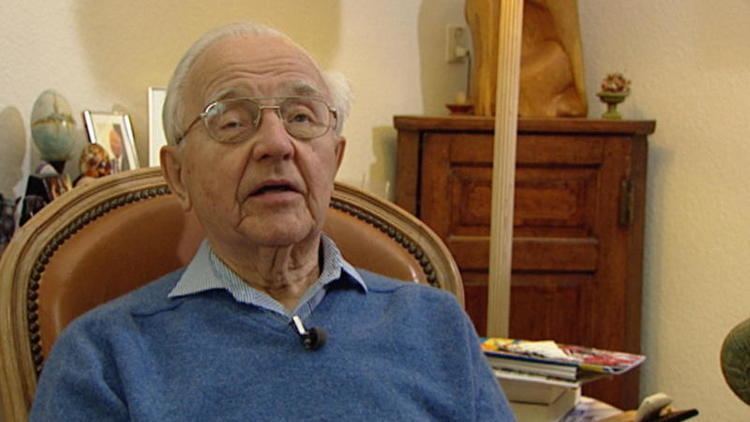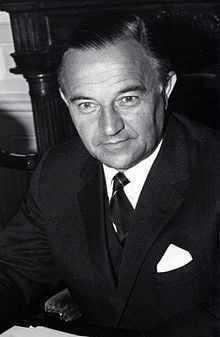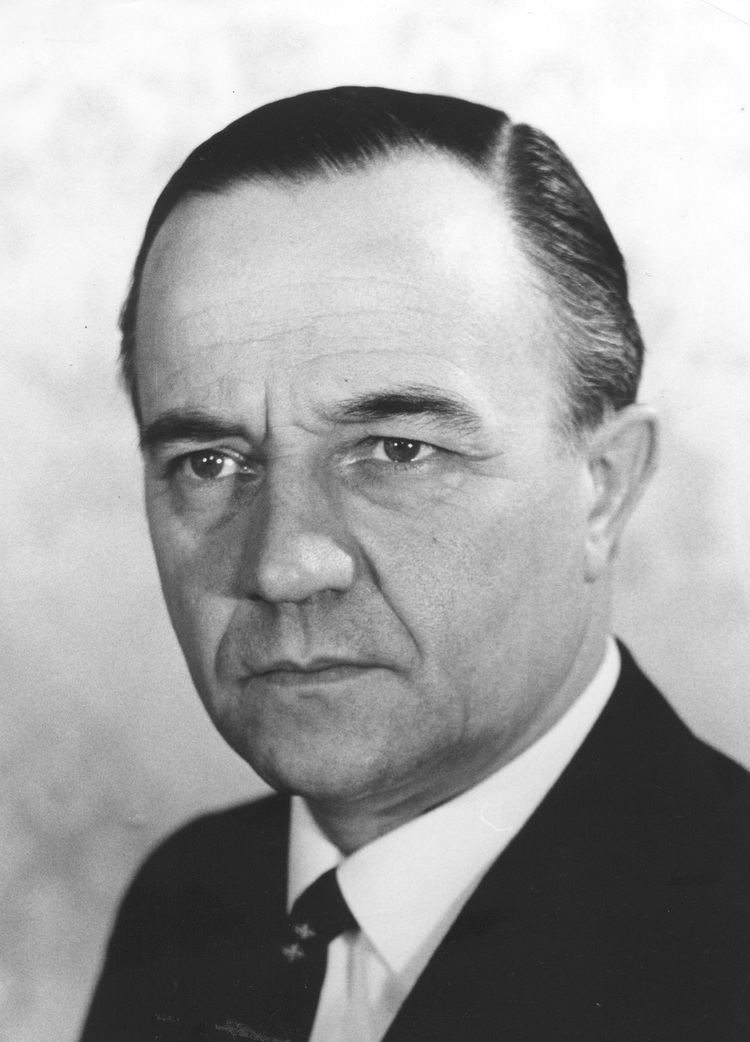Monarch Juliana Succeeded by Jan Teijssen Preceded by Jan Niers Alma mater Royal Naval College | Role Dutch Politician Name Piet Jong | |
Deputy Johan WitteveenJoop Bakker Spouse Anneke Bartels (m. 1947–2010) Children Gijs de Jong, Maria de Jong, Jos de Jong Similar People He Yingqin, Wladyslaw Sikorski, Gerd von Rundstedt, Heinz Guderian, John Vereker - 6th Visco | ||
Dutch Prime Minister escaping depth charges !
Piet de Jong benadrukt vrijheid van godsdienst (CDA Congres Rijnhal)
Petrus Jozef Sietse "Piet" de Jong, LVO, DSC ( [ˈpeːtrɵs ˈjoːzəf ˈsitsə ˈpit də ˈjɔŋ]; 3 April 1915 – 27 July 2016) was a Dutch politician and naval officer who was Prime Minister of the Netherlands from 5 April 1967 to 6 July 1971. He was a member of the Catholic People's Party (KVP), which later merged into the Christian Democratic Appeal (CDA).
Contents
- Dutch Prime Minister escaping depth charges
- Piet de Jong benadrukt vrijheid van godsdienst CDA Congres Rijnhal
- Early life
- World War II
- Undersecretary
- Minister
- Prime Minister
- After politics
- Reputation and legacy
- Personal
- Longevity
- Death
- References

De Jong joined the Royal Netherlands Navy Submarine Service and served on HNLMS O 24 during the Second World War, ending the war as the commanding officer of that vessel. During his service he was awarded the Bronze Cross twice, as well as the Distinguished Service Cross of the United Kingdom. After World War II De Jong continued to serve in the navy, commanding the HNLMS De Zeeuw from 1951 until 1952 and the HNLMS Gelderland from 1958 until 1959. Between his two assignments as commanding officer he served as chief of staff to Prince Bernhard of Lippe-Biesterfeld and aide-de-camp to Queen Juliana.

De Jong served as Undersecretary for the Navy from 1959 until 1963, then Minister of Defence from 1963 until 1967. After the Dutch general election of 1967, De Jong became Prime Minister of the Netherlands and Minister of General Affairs, leading the Cabinet de Jong. Despite his popularity, the Catholic People's Party refused to nominate him as the Lijsttrekker (top candidate) for the 1971 general election because of his alleged "conservative image".

After his premiership, De Jong remained in active politics and became the Parliamentary leader of the Catholic People's Party in the Senate and a Member of the Senate serving from 1971 until 1974, and finally retired from active politics at the age of fifty-nine. Following the end of his active political career, De Jong occupied numerous seats on supervisory boards in business and industry.

De Jong was known for his dry wit and quick remarks. His abilities as a team leader with perspective and pragmatism were greatly admired. The Cabinet De Jong was the first cabinet after World War II that completed a full term without any internal conflicts. By the time of his death in 2016 at the age of 101, he was the oldest and earliest serving former Prime Minister of the Netherlands and the oldest living state leader.
Early life
Petrus Jozef Sietse de Jong was born on 3 April 1915 in Apeldoorn in the Netherlands province of Gelderland in a Roman Catholic family that originated from Friesland, as the sixth of seven children of Joännes Jans de Jong (24 February 1878 – 28 November 1931), a railroad superintendent, and Gijsberta Adriana Schouten (29 December 1877 – 30 June 1957). After leaving secondary school, de Koninklijke Hogereburgerschool (now de Koninklijke Scholengemeenschap), he joined the Royal Netherlands Navy as a midshipman in 1931 and subsequently attended the Royal Netherlands Naval College in Den Helder. In 1934, he received his commission as a Sub-lieutenant.
World War II
After his graduation in 1934, he served a short time in the Dutch East Indies before he entered service in the Royal Netherlands Navy Submarine Service. On 13 May 1940, De Jong sailed to England on board the Dutch HNLMS O 24 and during World War II he saw action initially as first officer and from mid-1944 onwards as Commanding officer of that vessel. He lived in England during the World War II. In April 1946 he returned on board the HNLMS O 24 to the Netherlands. In 1947, he was attached to the Naval Staff of the Admiralty In 1948, he became adjutant to the Navy Minister.
From 1951 to the end of 1952, De Jong commanded a naval frigate HNLMS De Zeeuw, after which he joined the staff of the Allied Commander-in-Chief Channel in the British naval base at Portsmouth. In 1955, he was appointed Chief of Staff to the Inspector-General of the Royal Netherlands Navy Prince Bernhard of Lippe-Biesterfeld and aide-de-camp to Queen Juliana, after which he returned to sea in 1958 as commander of the submarine chaser HNLMS Gelderland.
Undersecretary
On 7 June 1959, during a NATO naval exercises near Scotland, De Jong received an unexpected telegram with the orders that he was to report the next day to Vice Admiral Leendert Brouwer, the Commander of the Royal Netherlands Navy himself, De Jong was summoned because of his "appointment" as Undersecretary for the Navy in the new Cabinet de Quay. De Jong was airlifted from the HNLMS Gelderland by helicopter and transported to the aircraft carrier HNLMS Karel Doorman. It was the second time that De Jong was asked for a political office, for the Dutch general election of 1956 he was approached by Carl Romme the leader of the Catholic People's Party for a seat in the House of Representatives but De Jong respectfully declined his offer, and stated: "I don't have political ambitions, I want to become an admiral".
During that time the independence of the Royal Netherlands Navy in the Armed forces of the Netherlands was in question, the main focus of the discussion was the new command structure for all the service branches. Both a horizontal-structure and vertical-structure had their proponents and opponents, the Royal Netherlands Navy was historically a proponent of a vertical-structure but the horizontal-structure received increasing support, including from the then Minister of War and the Navy Kees Staf. During the cabinet formation for the Cabinet de Quay the decision was made to go with the horizontal-structure and the first step was made with the combining of the Ministry of War and the Ministry of the Navy. With the combining of the ministries a serious efficiency problem in the Ministry of War was discovered, while the Ministry of the Navy was thought to be in an excellent administrative condition.
After his meeting with Admiral Brouwer, De Jong reported to the incoming Minister of Defence Sidney J. van den Bergh, who formally asked De Jong to become the new Undersecretary for the Navy. De Jong was given a few days to think it over and he used that time to speak with Carl Romme. De Jong informed him that he was not a member of the Catholic People's Party but Romme respond by saying: "You are not a member of a different party? No, but you are a Roman Catholic? Then we will we see you as one of us." Romme did advise De Jong to become a member of the Catholic People's Party after six months. On 11 June 1959, De Jong reported back to Van den Bergh and was told about the new horizontal-structure, De Jong who was a proponent of a vertical-structure was left with a few remarks. The next day the meeting was continued in the presence of the incoming Secretary-General for the Ministry of Defence Duyverman who was going to be responsible for all financial and budgetary affairs for the Ministry of Defence. De Jong objected, he thought he could not be politically responsible as an Undersecretary if he wasn't responsible for all financial affairs for his own department, Van den Bergh became irritated with De Jongs position on the matter and the meeting was adjourned for June 16, 1959.
Minister
Immediately thereafter, De Jong served as Minister of Defence in the successive Cabinets Marijnen, Cals and Zijlstra.
Prime Minister
From 5 April 1967 to 6 July 1971, he was Prime Minister of the Netherlands and Minister of General Affairs in the Cabinet de Jong. His Cabinet was the first Cabinet of the Netherlands since World War II that served a full four-year term without crises.
His cabinet was confronted with a demand for democratic reforms in the society and it decided to democratise colleges and universities after the famous Maagdenhuisbezetting. Plans were made to modernise politics by establishing an electoral system with districts or a chosen Prime Minister, but these plans were not implemented. Meanwhile, a pay pause due to the decision of employers and employees to raise wages was partly revoked after anti-government demonstrations and strikes. The Minister of Economic Affairs Leo de Block resigned, officially as a protest against the wage rise in the metal industry, but another reason was his slow reaction to the inflation and rising prices after the introduction of Value added tax. More unrest took shape in demonstrations against the Vietnam War. Internationally, relations with Indonesia improved, resulting in a visit by president Suharto which was, however, overshadowed by the occupation of the Indonesian embassy by Moluccans. The Soviet Union invasion in Czechoslovakia was seen as a reason to increase the defence budget. During his term as Prime Minister of the Netherlands De Jong met with numeral state leaders, including then President Richard Nixon, Presidents of France Charles de Gaulle and Georges Pompidou. He was present in the hospital when Prince Claus announced the birth of his son Willem-Alexander, Prince of Orange on 27 April 1967.
After serving as Prime Minister of the Netherlands De Jong became a member of the Senate, where he served from 1971 to 1974 and as the Parliamentary leader in the Senate. In 1972, he was passed by the Cabinet Biesheuvel II for the position of Vice President of the Council of State In 1973, he passed the mayoralty of Eindhoven.
After politics
Following the end of his active political career, De Jong occupied many posts in industry and seats on numerous supervisory boards. In December 1990 he was selected to lead a diplomatic mission to Iraq to free Dutch hostages, but ultimately the mission was cancelled.
On 25 March 2010, De Jong, still visibly spirituous and active, gave a speech at Nieuwspoort (Newsgate) about the publication of the biography of former Minister of Foreign Affairs and the 5th Secretary General of NATO Joseph Luns. On 24 April 2010 during the annual Christian Democratic Appeal party conference, De Jong spoke about former Deputy Prime Minister and Labour Party party leader Wouter Bos and his actions which led to the fall of the Cabinet Balkenende IV.
After the Dutch general election of 2010, the Christian Democratic Appeal (CDA) suffered a disappointing election result, and Informateur Ivo Opstelten announced the formation of a new centre-right coalition cabinet composed of the winner of the election, the People's Party for Freedom and Democracy (VVD), and De Jong's own CDA, but with the support of the Party for Freedom (PVV) of Geert Wilders. De Jong spoke against this support and said that the PVV's stand on freedom of religion was a deal-breaker.
On 30 March 2012, De Jong and several other prominent CDA members, including fellow former Prime Minister Ruud Lubbers, former Ministers of Foreign Affairs Hans van den Broek, Pieter Kooijmans and Ben Bot, former Ministers for Development Cooperation Piet Bukman and Agnes van Ardenne, and former ministers Wim Deetman and Ernst Hirsch Ballin and former Undersecretary Karien van Gennip all signed a petition of disapproval for the proposed cuts to the budget of international development by the Cabinet Rutte I. De Jong responded by announcing that he would leave the CDA if the cuts were implemented. He expressed satisfaction about the fall of the Cabinet Rutte I in 2012, calling it a "lame cabinet".
De Jong was present at the ascension of Willem-Alexander to the Dutch throne on 30 April 2013. He was Prime Minister at the time of the King's birth. At the age of 98 he was the oldest person attending the ceremony.
On 1 December 2013, De Jong and fellow former prime ministers Dries van Agt and Ruud Lubbers were present at the presentation of the book Polarisatie en hoogconjunctuur, a book about Dutch politics in the 1960s. De Jong received the first copy from incumbent Prime Minister Mark Rutte.
Reputation and legacy
During his time as Prime Minister of the Netherlands, he was accused of not showing enough strength and too little action when needed during the social revolution of the 1960s by some of the counterculture of that time. De Jong was frequently labelled as old-fashioned, and that old-fashioned image was reinforced by his bowler hat, which he wore frequently outside, a custom he picked up during his time living in England during World War II. In contrast the Silent majority were reported to be content with the policies of his cabinet. More than forty years later, De Jong is considered by many to have made well thought-out decisions during his time as Prime Minister and when needed showed enough strength with a far more progressive ideology than he was credited for at the time.
Politicians from the entire political spectrum have labelled De Jong as one of the better prime ministers of the Netherlands. In an episode of the Dutch television programme Netwerk aired in 2005, he is even labelled as perhaps the best postwar Prime Minister of the Netherlands. This view has been shared by numerous high-profile current and former Dutch politicians, including former Prime Minister Dries van Agt and former Deputy Prime Minister Hans Wiegel, who praised De Jong being perhaps the best Prime Minister after World War II. Former Member of the Senate and Righteous Among the Nations Johan van Hulst said that of all the prime ministers he worked with in twenty-five years, De Jong was the best. On 23 March 2011, the history channel Hollanddoc devoted an episode about his life with the quote "Attention for the least-known prime minister after World War II, but perhaps the most successful: Piet de Jong" In November 2011, the second edition of his in 2001 released biography Van buitengaats naar Binnenhof. P.J.S. de Jong (From offshore to Binnenhof. P.J.S. de Jong) became well received and further enhanced his reputation: "He showed himself a team leader with perspective and humor. The ideal manager in a time of crisis of authority, polarization and social unrest."
De Jong said to Queen Juliana, for whom he had served as aide-de-camp, when he was sworn in as Undersecretary, "Majesty, there you see how a person comes down in the world." (Dutch: "Majesteit, zo ziet u maar hoe een mens aan lager wal kan raken.") And in a response to a delicate question of a radio reporter, when asked what his thoughts on pornography were, he said, "As far as I know, pornography is the only working medicine against seasickness." When later a Belgian minister spoke negatively about the libertarian ideas of the Dutch on pornography, he responded, "Well, the Belgians aren't a seafaring people, are they?"
Personal
After World War II, De Jong married former resistance fighter Anna Geertruida Jacoba Henriëtte "Anneke" Bartels (born 8 January 1915). At the time when they met Bartels was serving in the women's division of the Royal Netherlands Navy. They married on 26 June 1947 and had one daughter and two sons, Maria (born 31 May 1948) Jos (born 31 August 1949) and Gijs (born 15 October 1952). Anneke Bartels died on 6 January 2010 two days before her ninety-fifth birthday after suffering from heart and lung illnesses since 2000.
Longevity
At the age of 101, De Jong was the oldest living and earliest serving former Prime Minister of the Netherlands and the oldest living former Member of the Council of Ministers of the Netherlands overall. De Jong was the second oldest Prime Minister of the Netherlands by age after Willem Drees who lived to 101 years, 314 days. At the time of his death, De Jong was the oldest living former head of state or government.
Death
Piet de Jong died on 27 July 2016 of natural causes after a brief illness in his home in The Hague. Having survived his wife by six years, he died at the age of 101 years, 115 days. De Jong was survived by his three children, eight grandchildren and fifteen great-grandchildren.
